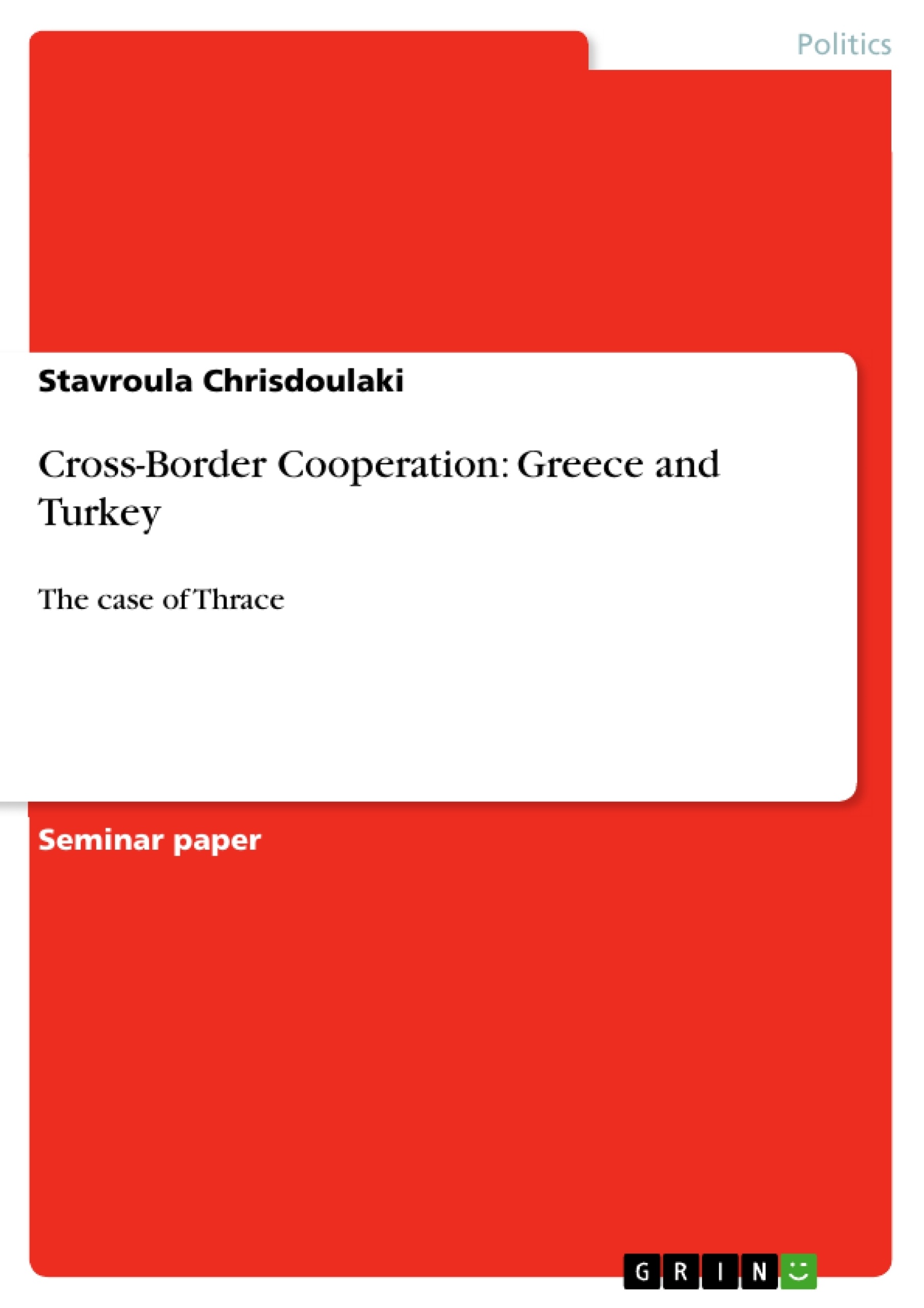In this paper will be examined the cross-border cooperation between Greece and Turkey and more specifically the cross-border region of Thrace will be analyzed in detail. The case of the Greek-Turkish cross-border region is becoming more interesting than other cross-border regions, since Greece is a member of EU from 1981 and Turkey is a candidate member since 2005, that is to say the cross-border area in between these countries consists of the external borders of the EU with a potential member state of EU. Furthermore, the region of Thrace (Western Thrace for Greece and Eastern Thrace for Turkey) not only consists of an important region in geopolitical terms for both of the countries, but also the current situation of cross-border cooperation in this particular region represents and in to some extend explains with the most concrete way the prevailed situation of cross-border cooperation in the whole cross-border area of Greece and Turkey, including the border region of the Aegean Sea with coastal Turkey, the sea borders between these countries. Namely, it is indicative that the region of Thrace participated in Interreg IIIA but was excluded in Interreg IV, fact that complexes the cross-border cooperation and will be analyzed in detail in the following chapters. Before analyzing the case of Thrace, it is essential to mention that Greece and Turkey have long history of conflict, which goes back to the dissolution of Ottoman Empire and the formation of the Greek independent state. Currently, there is no military conflict but there are still political matters that are questioned form the one or the other side. The disputable sea borders, the air space, the FIR of Athens and the minorities in both of the countries are some o-border cooperation in a successful way. In specific, in the case of Thrace, the Turkish minority in the Greek part of Thrace plays an important role for cross-border cooperation and can be considered as a parameter that is responsible for the current situation of non actual cooperation.
Inhaltsverzeichnis (Table of Contents)
- A. Introduction
- B. Theoretical Framework
- 2.1 Brunet-Jailly's Model of Successful Cross-Border Cooperation
- 2.2 Wilson and Donnan's Approach to Territory and Identity
- 2.3 Martinez's Borderlands Typology
- C. Cross-Border Cooperation in Thrace
- D. Cross-border Cooperation under Interreg IIIA-IV
- E. Conclusion
Zielsetzung und Themenschwerpunkte (Objectives and Key Themes)
This paper aims to examine the cross-border cooperation between Greece and Turkey, specifically analyzing the cross-border region of Thrace. The focus lies on understanding the challenges and opportunities for cooperation in this area, given the historical and political complexities between the two countries.
- Historical and political context of Greek-Turkish relations
- Theoretical frameworks for understanding cross-border cooperation
- The case of Thrace as an example of a 'sensitive' borderland
- The role of Interreg IIIA-IV programs in promoting cross-border cooperation
- Factors that influence cross-border cooperation, including minority populations and geopolitical tensions
Zusammenfassung der Kapitel (Chapter Summaries)
- Introduction: This chapter provides an overview of the paper's focus on cross-border cooperation between Greece and Turkey, specifically focusing on the region of Thrace. It highlights the unique context of this borderland, given the differing EU memberships of the two countries and the historical tensions between them. The chapter introduces the concept of cross-border cooperation and its relevance to the Greek-Turkish relationship, mentioning the role of the Turkish minority in Thrace as a key factor influencing cooperation.
- Theoretical Framework: This chapter explores three theoretical approaches that provide a foundation for understanding cross-border cooperation in the Greek-Turkish context. It examines Brunet-Jailly's model of successful cross-border cooperation, highlighting the importance of market forces, policy activities, local cross-border culture, and local political clout. It also delves into Wilson and Donnan's perspective on territory and identity, emphasizing the relationship between states, borders, and societies. Finally, it analyzes Martinez's typology of borderlands, placing the Greek-Turkish borderland within the category of 'Alienated Borderlands' characterized by tension and limited cross-border interaction.
Schlüsselwörter (Keywords)
Key terms and concepts include: cross-border cooperation, Greece, Turkey, Thrace, Interreg IIIA-IV, borderlands, alienated borderlands, political tensions, minority populations, geopolitical factors, EU membership, historical context.
- Quote paper
- Stavroula Chrisdoulaki (Author), 2010, Cross-Border Cooperation: Greece and Turkey, Munich, GRIN Verlag, https://www.grin.com/document/160551




